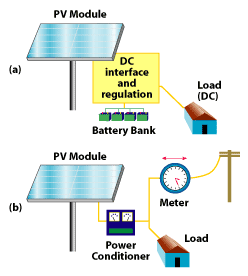small solar electric system balance-of-system components

Elements needed to get the power created by a PV system to the load (in this example, a house). The stand-alone PV system (a) uses battery storage to provide dependable DC electricity day and night. Even for a home connected to the utility grid (b), PV can produce electricity (converted to AC by a power conditioner) during the day. The extra electricity can then be sold to the utility during the day, and the utility can in turn provide electricity at night or during poor weather.
In addition to the solar cells and modules, a small solar electric system (or photovoltaic system) consists of other parts called balance-of-system components.
The balance-of-system equipment required depends which of the following systems is being used:
A typical small solar electric system usually includes the following balance-of-system components:
